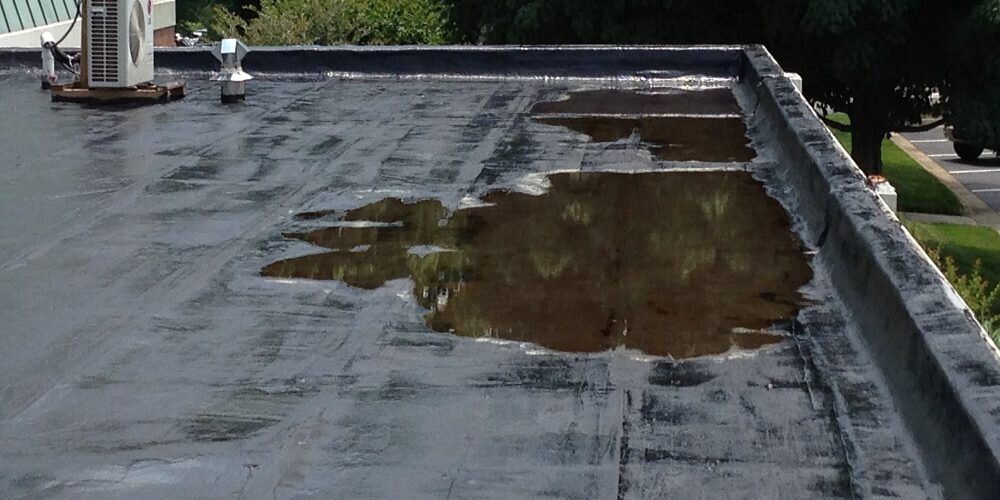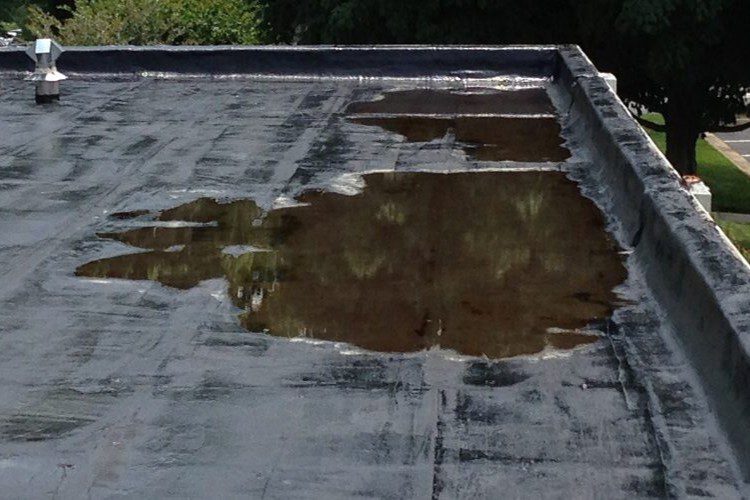Wondering What to do About Ponding Water?
Commercial roofing systems are prone to all sorts of issues arising from weather incidences that are often hard to see with the naked eye. While low-slope roofs, often associated with commercial properties, are constructed to withstand abuse from the elements, they have one particular downside — they’re usually out of sight.
Ponding water on commercial roofs is considered to be one of the most common threats to roof durability and is attributed to a large number of emergency service calls resulting in flat roof repair. While every occurrence of ponding water is not a telltale sign of damage to come, it should be monitored and addressed as soon as possible. This blog post should inform you of the main aspects of ponding water on flat roof systems.
What Does Ponding Water Mean?
Ponding water, often called ‘incidental ponding water,’ means that water from events like rainfall has accumulated in puddles on a flat roof system and has not drained away from the building via a drainage system. To a certain extent, every flat roof system is intended to withstand a reasonable amount of ponding water until it evaporates away, leaving the low-slope roof nice and dry. Forty-eight hours of ponding water is a typical safe duration for lingering rainfall pools.
Pools of water are most common in valleys on the roof, where two pitches come together. When the precipitation is excessive, it can lead to a large amount filling up quickly, therefore not drying in a desirable amount of time. It’s worth mentioning that ‘flat’ roof systems on commercial roofs still have a degree of slope to allow for positive roof drainage.
Ideally, the water from rainfall or a leftover pond from a fastidious roof cleaning can flow to a drainage point strategically placed on the roof, naturally leaving the surface dry after a few hours. When objects block these areas, ponding water on flat roofs is bound to appear.
Drains and other water-shedding mechanisms can become obstructed by leaves and other debris that clog gutters and cause ponds of rainwater to appear. Unfortunately, these instances can lead to troublesome damage for a flat roof system.
Property owners and managers must be aware of when and where ponding water occurs on the roof, and they should quickly develop a plan to clear off any excess pools before expensive roof damage, such as leaks and mold, appears.

What Does Ponding Water Mean?
Ponding water, often called ‘incidental ponding water,’ means that water from events like rainfall has accumulated in puddles on a flat roof system and has not drained away from the building via a drainage system. To a certain extent, every flat roof system is intended to withstand a reasonable amount of ponding water until it evaporates away, leaving the low-slope roof nice and dry. Forty-eight hours of ponding water is a typical safe duration for lingering rainfall pools.
Pools of water are most common in valleys on the roof, where two pitches come together. When the precipitation is excessive, it can lead to a large amount filling up quickly, therefore not drying in a desirable amount of time. It’s worth mentioning that ‘flat’ roof systems on commercial roofs still have a degree of slope to allow for positive roof drainage.
Ideally, the water from rainfall or a leftover pond from a fastidious roof cleaning can flow to a drainage point strategically placed on the roof, naturally leaving the surface dry after a few hours. When objects block these areas, ponding water on flat roofs is bound to appear.
Drains and other water-shedding mechanisms can become obstructed by leaves and other debris that clog gutters and cause ponds of rainwater to appear. Unfortunately, these instances can lead to troublesome damage for a flat roof system.
Property owners and managers must be aware of when and where ponding water occurs on the roof, and they should quickly develop a plan to clear off any excess pools before expensive roof damage, such as leaks and mold, appears.
Does Ponding Water Damage A Roof?
Ultimately, ponding water on flat roofs that are not dealt with properly will lead to damage like leaks and mold, requiring flat roof repair. When water is left on flat roof surfaces for too long it begins to saturate the roof membrane, breaking it down and rotting it away over time. Once this process starts, a major roof repair is needed, and the results will most likely be costly.
Once water has begun to pool on a flat roof, it will start to grow mildew, moss, and other organic matter — think of a pool of stagnant water that turns green and brown.
These ponds of water can seriously degrade and deteriorate the roof membrane and cause the decking and insulation to become saturated, spelling even more worries for the building manager. Those hoping to maintain a sound commercial roof structure should avoid wood rot and decay at all costs.
Causes of Water Ponding on Flat Roofs
What are the possible causes of water ponding on a flat roof? Here are the top five most common reasons for water ponding on flat roofs:
1- Poor Roof Design: Incompatible architectural plans can lead to ponding. Structural engineers can assess the overall system, including joists and beams, to prevent water accumulation.
2- Building Age and Foundation Settling: Settling a building’s foundation over time can alter the intended roof design, affecting drainage.
3- Rubber Roofs with Multiple Layers: The uneven placement of rubber layers over tar and gravel can exacerbate slopes, contributing to water ponding.
4- Crushed Insulation Causing Uneven Roof Slope: Malleable insulation materials may depress unevenly, creating areas prone to water accumulation. Adding more insulation or changing the strategy can rectify this issue. Products like GAF’s EnergyGuard™ Tapered Polyiso Foam Roof Insulation provide a slope, guiding water toward drains and gutters.
5- Lack of Drainage or Improperly Installed Drains: Proper drainage, including tapered insulation, is crucial. Local building codes often regulate drainage conditions to prevent water ponding.
Dangers of Water Ponding on Flat Roofs
Is ponding on a flat roof bad? Absolutely. Water ponding is a significant concern for both residential and commercial properties. When water accumulates on a flat roof, it can compromise the structural integrity of the entire building. While a certain amount of standing water on a flat roof is considered normal for a brief period, extended ponding for more than 48 hours poses serious risks such as:
Vegetation Growth: Prolonged water accumulation fosters moss, algae, and other plant growth, causing long-term damage.
Sagging Roof Deck and Potential Collapse: Water-saturated roofs deteriorate, increasing the risk of structural collapse over time.
Frequent Roof Leaks: Ponding accelerates the deterioration of roofing materials, leading to more extensive leaks.
How Do You Fix Ponding Water on a Flat Roof?
There are several ways to approach caring for low-slope roofs, and the first line of defense comes from something stated earlier — getting a professional set of eyes on the roof.
Since commercial roofing is often out of sight for most people on the ground, there is far less chance of anyone seeing problems beginning to develop. Schedule an appointment with a trusted commercial roofing company to safely and securely inspect the roof and to receive expert advice on actions to take.
If more than a simple cleaning of gutters and scuppers is necessary to improve roof drainage, they will most likely suggest some of the following solutions when ponding water is prevalent on your flat roof system:
Consider a Partial or Full Roof Replacement: Ponding water can be created from wet or damaged insulation, so removing and replacing these areas can help drastically. When replacing roof components under the surface membrane, a replacement is often necessary. You may also benefit from choosing a more suitable roof design that sheds water better. This is one of the most straightforward solutions for flat roof repair.
Consider a Tapered Roof System: Tapered insulation has a slight pitch, typically 1” over 8’, 1” over 4’, or 1” over 2’. While this sounds small, it makes a big difference on flat roofs holding water. The downside of tapered insulation is that it is costly. Creating a pitch like this on a flat commercial roof system can dramatically increase the amount of insulation used. Additionally, installing a tapered roof system is like installing a puzzle. Each piece has a place. So, installing a tapered roof system can substantially add to the cost.
Add Additional Drains: If interior plumbing can be added easily, installing additional drains is one of the easiest and most cost-effective solutions to ponding water on flat roofs, mainly if ponds are concentrated in just a few areas. A new drain with sumped insulation would be installed, making the roof area slightly lower around the drain. With the help of a licensed plumber connecting the drain inside the building, property owners can count on an effective roof drainage system.
Add A Scupper Box: If the ponding water is located near the edge of the building, or if interior plumbing is not an option, building owners could consider a scupper box and downspout. This would involve installing a new scupper box, downspout, and sumped insulation near the roof’s edge. Sumped insulation means that the insulation is lower around the scupper box than the surrounding roof, which helps promote drainage. When necessary, a more considerable relief can be cut into the roof so that water has a path to the downspout.
Trust The Professionals
Water ponding is often a consequence of poor roof design rather than the quality of roofing materials. Even the best materials can’t prevent ponding if the roof is not designed to allow proper drainage. Choosing a skilled and experienced roofer ensures the roof will be constructed correctly, minimizing the risk of ponding-related issues.
At Chaffee Industrial Roofing, we are dedicated to giving the best solutions for your roof. Whenever you need a flat roof repair or are simply looking for advice, we’re here to help. Don’t invest in your roof without consulting the team with over 115 years of experience. Call Chaffee Roofing today!
